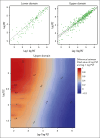Rising total leukocyte counts correspond with rising platelet counts in thrombotic thrombocytopenic purpura
- PMID: 40765932
- PMCID: PMC12320433
- DOI: 10.1016/j.bvth.2024.100024
Rising total leukocyte counts correspond with rising platelet counts in thrombotic thrombocytopenic purpura
Abstract
Thrombotic thrombocytopenic purpura (TTP) is a rare disorder involving pathological platelet-von Willebrand factor interaction, resulting in microvascular thrombosis. The consumption of platelets in TTP microthrombi results in severe thrombocytopenia which resolves with resolution of the microvascular thrombosis. Over the course of treatment, patient platelet counts often rise and fall multiple times before stable remission is achieved. On casual inspection, we noted that total leukocyte counts follow a pattern that appears to correspond to platelet counts. To explore whether changing leukocyte counts track significantly with changing platelet counts, we examined paired daily platelet counts and total leukocyte counts in 27 episodes of TTP in 13 patients across 2 institutions comprising 423 days of data. We modeled the nonlinear behavior in the data using a threshold mixed-effects regression model, in which we found a significant temporal relationship between total leukocyte counts and platelet counts. The model proved that, on a day when platelet counts were rising in previous days, the total leukocyte count is predictive of the rise in platelet count. The higher the total leukocyte count, the greater the rise in platelet count. Our results support the hypothesis that leukocytes play a role in the resolution of TTP microvascular thrombosis.
© 2024 by The American Society of Hematology. Licensed under Creative Commons Attribution-NonCommercial-NoDerivatives 4.0 International (CC BY-NC-ND 4.0), permitting only noncommercial, nonderivative use with attribution. All other rights reserved.
Conflict of interest statement
Conflict-of-interest disclosure: The authors declare no competing financial interests.
Figures






Similar articles
-
Pathogen-reduced platelets for the prevention of bleeding.Cochrane Database Syst Rev. 2013 Mar 28;(3):CD009072. doi: 10.1002/14651858.CD009072.pub2. Cochrane Database Syst Rev. 2013. Update in: Cochrane Database Syst Rev. 2017 Jul 30;7:CD009072. doi: 10.1002/14651858.CD009072.pub3. PMID: 23543569 Updated.
-
A therapeutic-only versus prophylactic platelet transfusion strategy for preventing bleeding in patients with haematological disorders after myelosuppressive chemotherapy or stem cell transplantation.Cochrane Database Syst Rev. 2015 Sep 30;2015(9):CD010981. doi: 10.1002/14651858.CD010981.pub2. Cochrane Database Syst Rev. 2015. PMID: 26422767 Free PMC article.
-
Comparison of different platelet count thresholds to guide administration of prophylactic platelet transfusion for preventing bleeding in people with haematological disorders after myelosuppressive chemotherapy or stem cell transplantation.Cochrane Database Syst Rev. 2015 Nov 18;2015(11):CD010983. doi: 10.1002/14651858.CD010983.pub2. Cochrane Database Syst Rev. 2015. PMID: 26576687 Free PMC article.
-
Prophylactic platelet transfusion for prevention of bleeding in patients with haematological disorders after chemotherapy and stem cell transplantation.Cochrane Database Syst Rev. 2012 May 16;2012(5):CD004269. doi: 10.1002/14651858.CD004269.pub3. Cochrane Database Syst Rev. 2012. PMID: 22592695 Free PMC article.
-
Pathogen-reduced platelets for the prevention of bleeding.Cochrane Database Syst Rev. 2017 Jul 30;7(7):CD009072. doi: 10.1002/14651858.CD009072.pub3. Cochrane Database Syst Rev. 2017. PMID: 28756627 Free PMC article.
References
-
- Subhan M, Scully M. Advances in the management of TTP. Blood Rev. 2022;55 - PubMed
-
- Furlan M, Robles R, Galbusera M, et al. von Willebrand factor–cleaving protease in thrombotic thrombocytopenic purpura and the hemolytic–uremic syndrome. N Engl J Med. 1998;339(22):1578–1584. - PubMed
-
- Masias C, Cataland SR. The role of ADAMTS13 testing in the diagnosis and management of thrombotic microangiopathies and thrombosis. Blood. 2018;132(9):903–910. - PubMed
LinkOut - more resources
Full Text Sources
